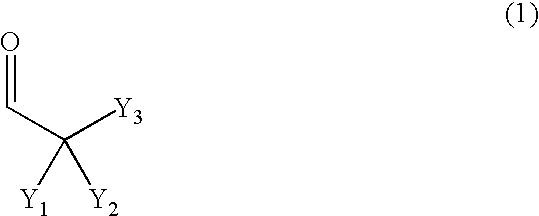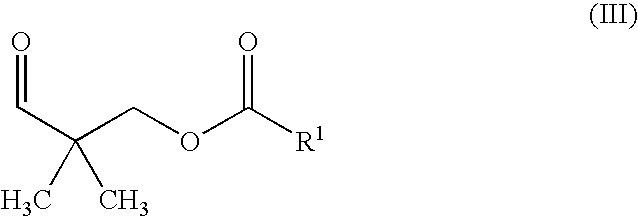Two-constituent polyurethance composition having high early strength
- Summary
- Abstract
- Description
- Claims
- Application Information
AI Technical Summary
Problems solved by technology
Method used
Image
Examples
examples
[0095] Polyols Used:
[0096] Acclaim® 4200 N (Bayer): linear polypropylene oxide polyol having a theoretical OH functionality of 2, an average molecular weight of about 4000, an OH number of about 28 mg KOH / g and a degree of unsaturation of about 0.005 meq / g.
[0097] Caradol® MD34-02 (Shell): nonlinear polypropylene oxide-polyethylene oxide polyol, ethylene oxide-terminated, having a theoretical OH functionality of 3, an average molecular weight of about 4900, an OH number of about 35 mg KOH / g and a degree of unsaturation of about 0.08 meq / g.
[0098] Caradol® ED56-11 (Shell): linear polypropylene oxide polyol having a theoretical OH functionality of 2, an average molecular weight of about 2000, an OH number of about 56 mg KOH / g.
Preparation of the Polyaldimines:
Polyaldimine A1
[0099] A round-bottomed flask was charged with 62.0 g of α,ω-polyoxypropylenediamine (Jeffamine® D-230, Huntsman; amine content=8.22 mmol NH2 / g). With thorough cooling and vigorous stirring, 89.5 g of 2,2-dime...
examples 1 to 7
[0106] Examples 1 to 7 demonstrate the preparation of two-component polyurethane compositions of the invention and their use as adhesives.
a) Preparation of the First Component (A):
[0107] In a vacuum mixer 2500 g of prepolymer 1, 1000 g of prepolymer 2, 3500 g of kaolin, 2540 g of urea thickener, 50 g of 3-glycidyloxypropyltrimethoxysilane (Silquest® A-187, OSi Crompton) and 10 g of benzoic acid were processed in the absence of moisture to form a lump-free, homogeneous paste.
[0108] Prepolymers 1 and 2 were Prepared as Follows:
[0109] Prepolymer 1: 1295 g of polyol Acclaim® 4200 N (Bayer), 2585 g of polyol Caradol® MD34-02 (Shell), 620 g of 4,4′-methylenediphenyl diisocyanate (MDI; Desmodur® 44 MC L, Bayer) and 500 g of diisodecyl phthalate (DIDP; Palatinol® Z, BASF) were reacted by a known method at 80° C. to form an NCO-terminated polyurethane prepolymer. The reaction product had a titrimetrically determined free isocyanate group content of 2.03% by weight.
[0110] Prepolymer 2: ...
example 13
[0159] This example demonstrates the preparation of a two-component polyurethane composition of the invention and its use as an adhesive.
[0160] In a vacuum mixer 1000 g of prepolymer 1, 1250 g of prepolymer 3, 1250 g of carbon black, 600 g of kaolin, 250 g of diisodecyl phthalate (DIDP; Palatinol® Z, BASF), 300 g of urea thickener, 25 g of 3-glycidyloxypropyltrimethoxysilane (Silquest® A-187, OSi Crompton), 325 g of polyaldimine 3 (i.e., NH2 / NCO=0.66) and 5 g of benzoic acid were processed in the absence of moisture to form a lump-free, homogeneous paste.
[0161] Prepolymer 1 and the urea thickener were prepared as described in Example 1.
[0162] Prepolymer 3 was prepared as follows:
[0163] 1770 g of polyol Acclaim® 4200 N (Bayer) and 230 g of 4,4′-methylenediphenyl diisocyanate (MDI; Desmodur® 44 MC L, Bayer) were reacted by a known method at 80° C. to form an NCO-terminated polyurethane prepolymer. The reaction product had a titrimetrically determined free isocyanate group content ...
PUM
| Property | Measurement | Unit |
|---|---|---|
| Molar mass | aaaaa | aaaaa |
| Equivalent mass | aaaaa | aaaaa |
| Temperature | aaaaa | aaaaa |
Abstract
Description
Claims
Application Information
 Login to View More
Login to View More - R&D
- Intellectual Property
- Life Sciences
- Materials
- Tech Scout
- Unparalleled Data Quality
- Higher Quality Content
- 60% Fewer Hallucinations
Browse by: Latest US Patents, China's latest patents, Technical Efficacy Thesaurus, Application Domain, Technology Topic, Popular Technical Reports.
© 2025 PatSnap. All rights reserved.Legal|Privacy policy|Modern Slavery Act Transparency Statement|Sitemap|About US| Contact US: help@patsnap.com



